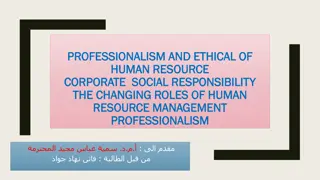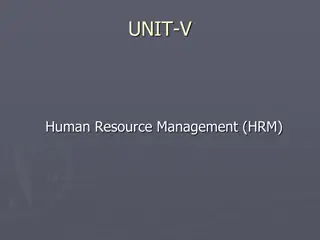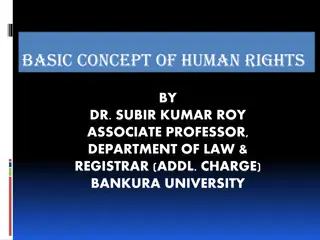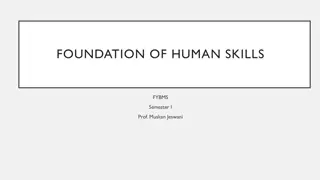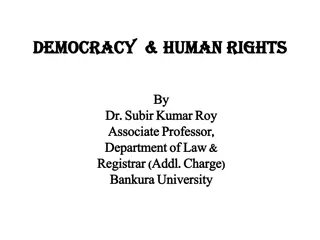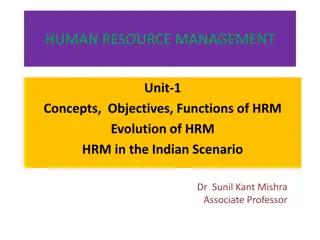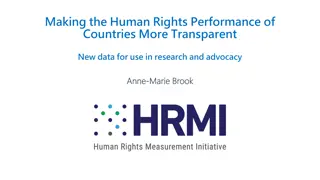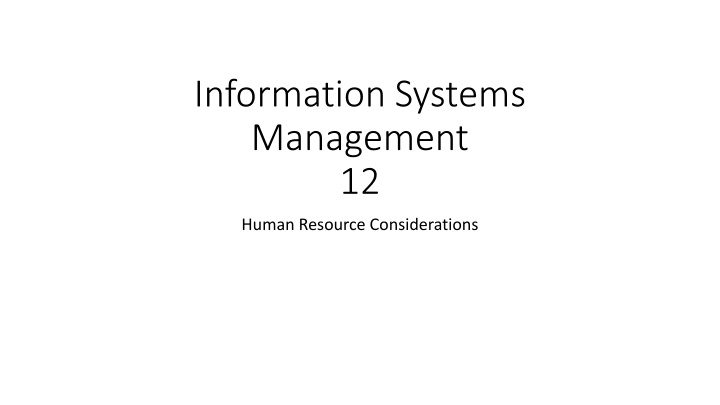
Insights into Information Systems Management and IT Workforce Trends
Explore the latest trends in Information Systems Management and the growing IT workforce, including human resource considerations, market insights, skills framework, and more. Gain valuable information on IT career development, skills required for success, and retention strategies for IT talent.
Uploaded on | 2 Views
Download Presentation

Please find below an Image/Link to download the presentation.
The content on the website is provided AS IS for your information and personal use only. It may not be sold, licensed, or shared on other websites without obtaining consent from the author. If you encounter any issues during the download, it is possible that the publisher has removed the file from their server.
You are allowed to download the files provided on this website for personal or commercial use, subject to the condition that they are used lawfully. All files are the property of their respective owners.
The content on the website is provided AS IS for your information and personal use only. It may not be sold, licensed, or shared on other websites without obtaining consent from the author.
E N D
Presentation Transcript
Information Systems Management 12 Human Resource Considerations
Outline Market for IT professionals SFIA What IT professionals seek in a position Future for IT professionals Skills required for successful IT future Retention of IT talent IT career development
DoE Labour Market Research Information Technology (IT) Professions, Dec 2015 https://docs.employment.gov.au/system/files/doc/other/ausitprofessions_1.pdf ICT labour force Professional, Scientific and Technical Services (includes most IT related workers) Australian Jobs 2019 Australian Jobs 2019 3
ICT vacancies DoE Labour Market Research Information Technology (IT) Professions, Dec 2015 https://docs.employment.gov.au/system/files/doc/other/ausitprofessions_1.pdf 4
ICT workforce The number of technology workers grew by more than 48,000 additional workers from 2018, bringing the total to 772,125 in 2019.1,2 This represents growth of 6.8% in a year. The technology workforce has grown 1.5 times faster than the increase for professional occupations (4.5%) more broadly pointing to continued strength in demand for technology workers across the economy. 13.7% growth in technical and professional workers. (Deloitte Access Economics and ACS Digital Pulse, 2020). 5 (Deloitte Access Economics and ACS Digital Pulse, 2020, p11)
Detailed ICT jobs current situation Australian Jobs 2019, p49
Skills Framework for the Information Age (SFIA) Currently at SFIA v7, but v8 due for release early in 2021 Framework for describing key skills and competencies required in ICT roles Grouped into a range of key areas, individual skills described at levels from 1 to 7 Skills mapping can be done by individuals and organisations individuals can map out skills/levels they currently have, use this to target jobs and career development organisations can map out skills/levels required by various jobs, use this to help with recruitment, skills planning and development Promoted in Australia by the ACS, and used across industry and government
What IT professionals are looking for Career advancement Salary requirements Empowerment to affect company success Ability to telecommute Discuss career goals with management Reasonable workload Company-sponsored training and seminars Less stress
Becoming a first-line manager Understanding organisational philosophy, strategic goals and objectives, and business processes Become responsible for output of other people Act as leader Stay informed on technical issues Acquire new and unfamiliar administrative duties Deal with employees and their problems Face new situations that have unclear action requiring judgment 10
Problems of retention of IT talent Traditionally the IT sector has had a high turnover of workers, but turnover drops off in more difficult employment times Difficult to know how to plan to use human resources Disruptive to organisation and negative impact on morale when talented workers leave There are real costs of losing skilled employees and replacing them estimated that it can cost an organisation between 1 and 2 years salary to replace professional workers 11
Gartners successful retention guidelines Compensation Pay within 10% of market rates Allow IT function managers greater flexibility Build defensive intelligence sources and survey often Set aside money for training that vests over time Offer time and performance based bonuses that pay out over 3-5 year period Tuition/education reimbursement Stock options, health insurance Training Invest in training and upgrading skills Work Environment Provide chance to work with new technologies Make work environment fun Recognition programs 12
Gartners successful retention guidelines Lifestyle benefits Casual dress, telecommuting, flexible hours, sabbaticals Eliminate Burnout Through Staffing/Time Off Ensure support models limit after hours work Offer time-off to employees who put in long hours Poll Employees Employee satisfaction data once a year 360 review process Hire Appropriate Profile Beware of go-getters Understand person s cultural fit within organisation Open Career Paths No artificial boundaries on career ladders Allow people to build process management skills 13
Source: Personnel Decisions Inc., Minneapolis, MN, http://www.personneldecisions.com 15 Luftman, 2004 Fig 9-10
Motivation factors for IT staff Morale is important and is a key priority for managers Allow people to learn new technologies Give people necessary resources Be competitive in terms of salary and benefits Provide for worker s personal development Provide strong leadership during rapid change Make certain people perceive that work is meaningful 16
IT management can reduce IT staff stress Keep staff updated on project status Let people know what is expected Set priorities Manage deadlines Make sure staff takes breaks regularly Make sure staff aware of updates on latest developments Encourage staff to ask for help Provide ergonomic work environment Career Development 17
Ethical Conduct and Data Mgt IT is the steward of corporate data and is responsible for managing it over its life cycle this is a valuable corporate asset and it is important that it is managed appropriately IT should provide training in ethical conduct Employees need to understand rules of ethical behaviour and actions Enforce ethical conduct on all including management of the organisation Bring visibility to all information Formal and on-the-job 18
19 Luftman, 2004 Fig 9-15
Reading and references Luftman, chapter 9 various Department of Education, Skills and Employment reports eg: Australian Jobs 2019 https://docs.employment.gov.au/documents/australian-jobs-publication Labour Market Research Information Technology (IT) Professions, Dec 2015 https://docs.employment.gov.au/system/files/doc/other/ausitprofessions_1.pdf ABS job vacancies by industry https://www.abs.gov.au/statistics/labour/employment-and-unemployment/job-vacancies-australia/latest-release Deloitte Access Economics and ACS 2020 ACS Australia s Digital Pulse: Unlocking the potential of Australia s technology workforce http://www2.deloitte.com/au/en/pages/economics/articles/australias-digital-pulse.html (earlier versions of the Digital Pulse publications are also available from this site) Gartner retention guidelines Skills Framework for the Information Age SFIA https://sfia-online.org/en 20


